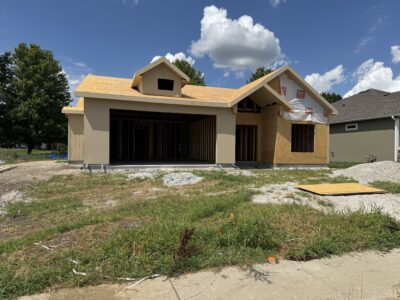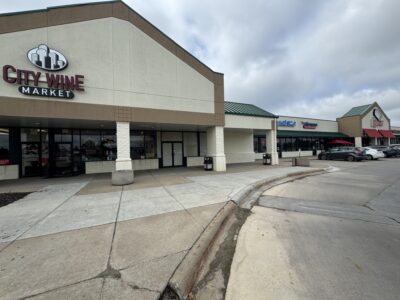
By one measure Douglas County has the highest property tax rate of any large county in Kansas, but why?

photo by: AdobeStock
Lawrence City Manager Craig Owens understands that residents are particularly focused on one part of his 2025 recommended budget — the proposed 3.5 mill property tax rate increase.
If approved, the 3.5 mill increase would be the city’s largest property tax rate increase in at least 50 years. While that is an eye-catcher, Owens does wish the public would pay a bit more attention to one other line that was included in the recommended budget that he released last month.
In that budget document, he labels the city’s tax base as “dominated by residential and tax-exempt properties,” and says that the community needs to “rebalance our priorities.”
In a follow-up interview with the Journal-World, Owens was more pointed about the shortcomings of Lawrence’s economy.
“To put a finer point on that, we are almost all residential and tax exempt, and we have a very high demand for public services, especially municipal public services,” Owens said. “We need to grow our commercial tax base or change our appetite.
“I don’t know how people in this community don’t understand that, but they don’t talk like they do.”
Owens said the unbalanced nature of Lawrence’s economy was clear to him on nearly his first day on the job.
“To me, it slaps you in the face as soon as you come into town,” Owens said.
Maybe this will be the year — spurred by the historic tax rate proposal — that the issue gets more attention. The proposed tax increase already has received significant pushback. Two of the five city commissioners already have come out in opposition to the proposed increase.
When you dig into the numbers, you can get a sense of why Lawrence residents may be frustrated with property taxes. The Journal-World gathered data for the 10 most-populous counties in Kansas, relying on figures from the Census Bureau and Kansas’ Division of Property Valuation, which is home to the state’s largest cache of statistics on local property taxes.
What the Journal-World review found is that Douglas County currently — meaning before the city’s proposed tax rate increase is taken into account — has the highest effective property tax rate of any of the state’s large counties.
Douglas County residents, on average, pay 6.95% of their household income in local property taxes, which includes taxes not just for the city but also for county government, school districts, townships and other such entities. The average tax rate for the other nine counties was 4.67%. If Douglas County’s tax rate simply matched that average, the typical homeowner in Douglas County would save about $1,500 a year in property taxes.
That’s the slap in the face that stings.
Key comparisons among the 10 largest counties in Kansas
Percent of assessed valuation from residential property: Leavenworth: 78%; Johnson: 70%; Douglas 68%; Riley: 68%; Sedgwick 63%; Shawnee: 62%; Butler: 58%; Saline: 56%; Wyandotte: 54%; Reno: 49%.
Percent of assessed valuation from commercial property: Wyandotte: 36%; Sedgwick: 28%; Saline: 27%; Johnson 26%; Shawnee: 25%; Riley: 22%; Butler: 19%; Douglas 19%; Leavenworth: 10%.
Average county mill levy rates for 2023: Wyandotte: 165 mills; Reno: 153 mills; Shawnee: 146 mills: Riley: 143 mills; Butler: 139 mills: Douglas: 128 mills; Saline: 126 mills; Leavenworth: 119 mills; Sedgwick: 119 mills; Johnson 110 mills.
Median home value: Johnson: $369,400; Douglas: $308,800; Leavenworth: $261,400; Riley: $217,900; Sedgwick: $197,700; Butler: $190,600; Wyandotte: $174,500; Shawnee: $166,900; Saline: $161,900; Reno: $119,200.
Median household income: Johnson: $98,523; Butler: $80,853; Leavenworth: $77,925; Douglas: $65,774; Sedgwick: $64,286; Shawnee: $60,544; Saline: $59,887; Wyandotte: $59,362; Reno: $57,390; Riley: $53,043.
Property tax as a percentage of household income: Douglas: 6.95%; Riley: 6.76%; Wyandotte: 5.61%; Johnson: 4.77%; Shawnee: 4.63%; Leavenworth: 4.62%; Sedgwick: 4.23%; Saline: 3.94%; Butler: 3.77%; Reno: 3.66%
Breaking it down
How did Lawrence end up with the highest rate? That’s one question to ask. Another, though, is to ask how these other communities ended up with a lower rate. Maybe we can reverse engineer our way to a lower rate. Or, maybe not. (I never reverse engineer anything I build. It is too difficult to get the duct tape back on the roll.) Let’s see by asking a series of questions.
— Do communities with larger commercial tax bases always have lower property tax rates? No, unfortunately for those looking for a simple answer. There’s no reason to think that growing our commercial tax base is a bad idea. It almost certainly is not. However, the numbers suggest a larger commercial tax base is not a magic bullet to ward off higher property taxes.
The Numbers
Take a look at property tax, housing and other data for the 10 most populous counties in Kansas.
If it were, Wyandotte County — home to Kansas City, Kan., — should have the lowest property tax rate among the big counties. Wyandotte’s tax base is 36% commercial. The average for the group is 23%. Yet, even though Wyandotte is way above average, its effective property tax rate is the third highest in the group at 5.6%.
Alternatively, Leavenworth County should have horrendous property taxes. Home to prisons and military bases — both of which are off the tax rolls — Leavenworth’s tax base is just 10% commercial. No one else in the group is nearly that low, yet Leavenworth’s effective tax rate is 4.6%, putting it in the middle of the pack and basically right at the average.
— Does population growth lead to lower property taxes? Does it lead to higher taxes? The answer to both questions is likely no. Butler County, next door to Wichita, had the second highest population growth from 2021 to 2023. Its tax rate was the second lowest among the group at 3.77%. That points to population growth being an antidote to higher property taxes. However, you don’t have to look hard to find evidence to the contrary. Reno County — home to Hutchinson — has the lowest effective property tax rate at 3.66%. Reno is losing population, down 0.62% since 2021. More dramatic is Saline County. Its population is down more than 2% since 2021, yet its effective property tax rate is the third lowest among the group.
— Does living in a college town make for higher property taxes? Maybe. The Kansas data suggests so, but it is a really small sample size. Douglas and Riley counties — home to KU and K-State — had the two highest effective property tax rates among the group of 10. But those two counties are really the only true “college-town communities” in the state.
The idea behind property taxes being higher in a college community is simple enough, though. None of the buildings of your largest employer is on the tax rolls. Furthermore, that large employer draws lots of people to town who live in residences — dorms — that also aren’t on the tax rolls. Dorm residents, for example, require city and county services, but the dorm properties aren’t generating any property taxes to pay for those services.
The type of communities most similar in those regards might be military towns. The military bases aren’t on the tax rolls, and just like students, there are a lot of soldiers and their families living in base housing that also does not pay property taxes.
Kansas has two counties where military bases play an outsized role in the local economies — Leavenworth and Geary, which is home to Fort Riley. Their property tax rates, though, aren’t particularly high. Leavenworth’s is 4.62%, which is slightly below the average of the 10 counties. Geary isn’t part of the 10 largest counties, but its tax rate comes out to 4.46%, well below its next door neighbor of Riley County.
Those numbers give me pause in saying that Douglas County’s property tax situation is largely tied to its role as a college town. But, it may merit some additional attention.
— Do high housing prices lead to high property taxes? I wouldn’t quite put it that way. Johnson County has the highest housing prices in the group. But its effective property tax rate is right about average at 4.77%. The reason that is so is because Johnson County also has the highest household income in the group.
But if we change the question slightly, we may be on to something: Do affordable housing prices lead to lower property taxes? The data seems to say yes. I measured housing affordability by comparing average home values to average household incomes in each of the 10 counties. Douglas County’s average home value is 4.69 times higher than the average household income. That is highest among the 10 counties, and Douglas County’s effective tax rate is highest as well. Riley County is second highest in home value vs income, and its tax rate is second highest.
At the other end of the scale, Reno County had the lowest home value versus household income number. An average home there is 2.04 times an average household income. Reno County has the lowest tax rate among the 10 counties. Butler County has the second lowest home value vs income score, and it has the second lowest tax rate in the group. Saline County is third in home value versus income and has the third lowest property tax rate.
The results get more muddled after that, but compared to everything else we’ve looked at, housing affordability appears to be a big factor on property tax rates.
Wrapping it up
So, what do these numbers say about a path forward for Lawrence and Douglas County? Well, probably as much as anything, they say that nothing is simple about property taxes.
But, the numbers perhaps say that diversification of Lawrence’s economy beyond a college town is important. Basically, that’s what Owens is saying too — grow the commercial tax base, which means you are growing something besides KU. Wichita might be a good example of the power of diversification. Sedgwick County has both a major university and a large military base. Yet, Sedgwick County’s property tax rate is below average. Wichita’s economy is definitely diversified beyond either a college town or a military town.
Secondly, the numbers perhaps argue for deeper thinking about affordable housing. Lawrence and Douglas County is doing a lot on that front, but most of the activity has been focused on building subsidized housing units. While that has its benefits, it seemingly doesn’t do much to change the structural issues that exist in the Lawrence housing market. Do we understand what those structural issues are? Is it as simple as we need to build more houses to keep up with demand? If so, why aren’t market forces causing that building to occur? Is there something else we are not seeing?
As I said earlier, nothing is simple about property taxes. However, I would like to amend that statement slightly. I do have one question that seems to have a clear-cut answer.
— Are homeowners carrying a bigger burden of property taxes than they used to? Absolutely. In researching this article, I found a chart produced by the state’s Division of Property Valuation. It shows the value of the state’s appraised value tax base, broken down by different types of property.
In 1993, residential property comprised 55% of the state’s tax base. By 2003, it had grown to 65% of the state’s tax base. By 2013, it had fallen to 62%, but the reprieve was brief. In 2023, residential property made up 74% of the state’s tax base. Every other category of property — commercial, public utility, agriculture, oil and gas — has fallen in that time period.
Those numbers maybe don’t point to a path ahead, but they probably do point to why so many homeowners are mad about property taxes.

photo by: Kansas Division of Property Valuation
A chart from Kansas’ Division of Property Valuation shows how much more reliant the state’s tax base has become on residential property.







